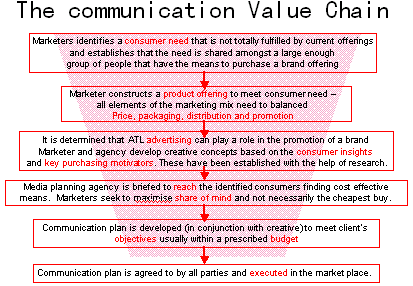12 November 2002
Maserame Tshwaedi (Saarf board member)
Refer Appendix 10.2: Segmentation in South African Marketing and Advertising Industries
Introduction
Almost 10 years after the end of the apartheid era we cannot deny that racism still exists in society and we, the communications industry, cannot be exempt. We do not support racist practices in any way and would like to eradicate them completely from all our activities.
Proposed definition of unfair discrimination within the communications industry
With particular reference to our industry, unfair discrimination is where intentionally or unintentionally, the communication efforts of a brand alienate certain sectors or limit people's access to information.
The Value Chain
In order to understand the marketing process and chain of decision making it is important to understand the various roles that marketers, advertising and media agencies have in directing communication decisions. Clients (marketers), besides being at the start of the value chain, also have the largest sphere of influence - throughout the communication development process. They are the holders of the purse strings. The media agencies operate at the lower end and by and large dominate the interface with media owners. Media owners can influence decisions up the value chain through strategically appropriate selling opportunities.

Factors that influence Communication investment
- Return on investment - communication spending must provide a direct return on investment within a defined period of time.
- Economic Climate - the communication industry operates in the broader economy and is often the first industry to feel economic downturns as well as the upswings. Advertising is considered a catalyst to fuel economic growth.
- Measurement - Most non-traditional media opportunities are not measured either in terms of adspend or audience. As an industry we know very little about possible R6-R8 million spent on Below-The-Line (BTL).
- Innovation - communication efforts are often focused on new things to say about a brand offering. Innovation is often around adding value to a product offering and commanding a price premium as a result.
- Consumer needs and wants - marketing attempts to match consumer needs with a unique product offering.
Why Segment?
Segmentation tools assist in grouping together "like" people in order to make sense of a brand's relative potential in the market place and to maximize opportunities to reach these groups. Many tools exist, and a combination of them should lead to a thorough understanding of the market. Most importantly, these tools should allow the user to access and measure changes in the identified segments over time.
Types of Segmentation approaches
-
Geographic -does exist in South Africa, particularly between coastal and inland areas. However most marketers approach brand communication at a national level.
-
Demographic - age, gender and economic status are the most commonly used demographics. Media space and time can only be bought against demographics.
- Universal LSMs - SAARF, through a cluster analysis use 29 demographic variables, break the population into 10 groups defining their socio-economic status. LSMs can only be based on the variables in AMPS and have been criticised for being euro-centric in their wealth measurement. They should not be used in isolation.
-
Race - in targeting is not common practice, marketers would limit their own businesses to target a product to one particular race group at the exclusion of another.
-
Volume - following the 80/20 principal - marketers attempt to focus on those consumers that contribute the most to volumes and or profits.
-
Brand usage - targeting specific users of a brand and matching communication vehicles accordingly. This will be available to SA marketers in 2003 via SAARF and TGI on a user pay basis.
-
Personality/ Lifestyle / Self-concept / Benefit and Value segmentation - all of these methods provide marketers with insights into consumers minds the way they feel about brands. They help to group consumers from a wide range of backgrounds and demographic status into "like-minded" segments. Various approaches exist that are normally proprietary to the individual clients.
Where we go wrong
-
By approaching today's marketing efforts off a historical knowledge base - and yesterday's understanding of the consumer landscape. Ours is a dynamic market that is changing in the middle and upper end. Worldwide, there is still no scientific tool to reliably predict potential consumer off-take within a defined period of time.
-
Insufficient first had experience of consumers across the spectrum of SA society.
-
Junior people making and driving the communication planning with insufficient mentoring and systematic processes to follow.
- Lack of access to our industry to all South Africans.
Recommendations
-
Transformation:- Marketers (because they control the budgets), must take the lead in driving the transformation process and to demand the same of their communication agencies.
-
Systems: -Management, within marketer and agency companies must institute strong systems to ensure that yesterday's paradigms are continually being challenged by today's market realities. These systems should includes, ongoing immersion programmes, training and mentoring programmes, marketing processes, recruitment policies etc.
-
Representivity:- The marketing and agency environments must strive to be representative of South African society. Each organisation should set its own targets and time frames to achieve this.
-
Professional Service:- Media owners should be deserving of adspend not only because of the audience they attract, but because of their professional implementation and service. Something must be sold before it can be bought. Media owners must take reponsiblity for their pricing and sales policies.
- Research:-
- We need to develop the industry's research (in particular the SAARF products) to become more reflective of South African society and introduce African indicators of wealth.
- SAARF (industry) data should not be abused through naive interpretation and application. The Universal LSMs should not be used in isolation as the only targeting variable.
- We believe the introduction of branded data to the country will provide a major step forward in truly matching brand consumers to media opportunities.
- Maserame Tshwaedi - Saarf board member

